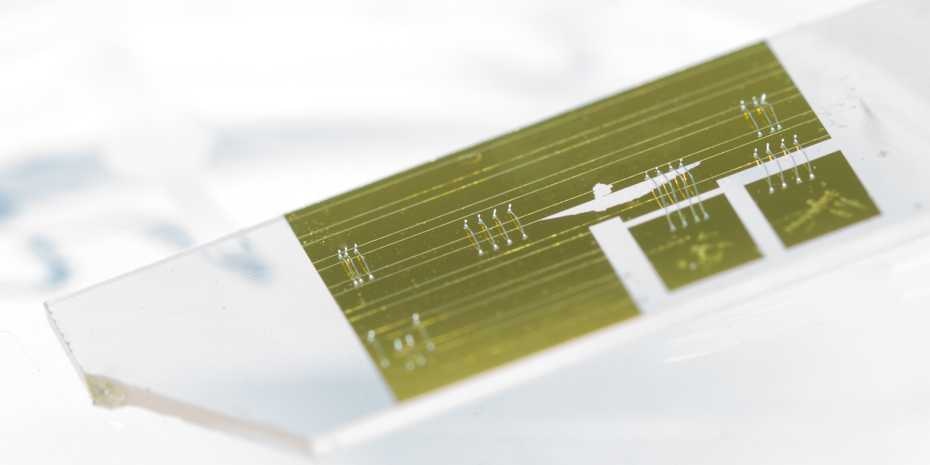Oct 10 2019
Currently, a mobile phone can perform virtually anything: take photos or video, transmit messages, establish its current location, and convey telephone conversations. These all-around devices might even be used to determine how ripe a fruit is or a beer’s alcohol content.
 Approximately 2 cm in length, this chip makes it possible to precisely analyze the infrared spectrum. (Image credit: ETH Zurich/Pascal A. Halder)
Approximately 2 cm in length, this chip makes it possible to precisely analyze the infrared spectrum. (Image credit: ETH Zurich/Pascal A. Halder)
At first sight, the concept of using mobile phones for chemical analyses looks like a bold one. After all, the infrared spectrometers currently used for such analyses usually weigh several kilograms and are hard to incorporate into a handheld device.
At present, scientists from ETH Zurich have taken a crucial step toward converting this vision into reality. David Pohl and Marc Reig Escalé, part of the team headed by Rachel Grange, Professor of Optical Nanomaterials in the Department of Physics, partnered with other colleagues to create a chip measuring about 2 cm2. This chip can be utilized for examining infrared light in the same manner as a conventional spectrometer does.
Waveguides Instead of Mirrors
A traditional spectrometer divides the incident light into two paths and then reflects it off two mirrors. The reflected light beams are recombined, and a photodetector is used to measure the light beams. When one of the mirrors is moved, an interference pattern develops. This pattern can be used to establish the proportion of various wavelengths in the incoming signal.
As chemical substances form typical gaps in the infrared spectrum, researchers can use the resulting patterns to recognize the constituent substances of the test sample and their concentrations.
This same concept underlies the mini-spectrometer created by the ETH scientists. However, movable mirrors are no longer used to examine the incident light in their device; by contrast, special waveguides with an optical refractive index that can be modified externally via an electric field are used.
Varying the refractive index has an effect similar to what happens when we move the mirrors. So this set-up lets us disperse the spectrum of the incident light in the same way.
David Pohl, Researcher, ETH Zurich
A Challenging Structuring Process
Based on how the waveguide is configured, scientists can analyze various parts of the light spectrum. “In theory, our spectrometer lets you measure not only infrared light, but also visible light, provided the waveguide is properly configured,” stated Escalé.
Contrary to other integrated spectrometers that have the ability to cover only a narrow range of the light spectrum, the device created by Grange’s team has a huge advantage since it can effortlessly examine a wide section of the spectrum.
Together with its compact size, the ETH physicists’ novel device provides two other benefits: the “spectrometer on a chip” needs to be calibrated just once, compared to traditional devices that must be recalibrated multiple times. Moreover, since it has no moving parts, it needs less maintenance.
For their spectrometer, the ETH scientists used a material that is also utilized as a modulator in the telecommunications sector. This material has a number of positive characteristics; however, as a waveguide, it limits the light to the inside. This is less than optimal as a measurement is feasible only if some portion of the guided light can escape out. Therefore, the researchers attached fragile metal structures to the waveguides that disperse the light to the outside of the device.
It required a lot of work in the cleanroom until we could structure the material the way we wanted.
Rachel Grange, Professor of Optical Nanomaterials, Department of Physics, ETH Zurich
Perfect for Space
However, until the existing mini-spectrometer can really be combined into a mobile or other electronic device, there is still specific technological advancement to be achieved.
At the moment we’re measuring the signal with an external camera. So if we want to have a compact device, we have to integrate this as well.
Rachel Grange, Professor of Optical Nanomaterials, Department of Physics, ETH Zurich
Initially, the physicists were focusing not on chemical analyses but on a totally different application: in astronomy, infrared spectrometers offer useful information about distant celestial objects. Since the earth’s atmosphere absorbs a large quantity of infrared light, it would be perfect to station these instruments on telescope or satellites in space.
A small, lightweight, and stable measurement device that can be propelled into space comparatively economically would naturally offer a significant advantage.